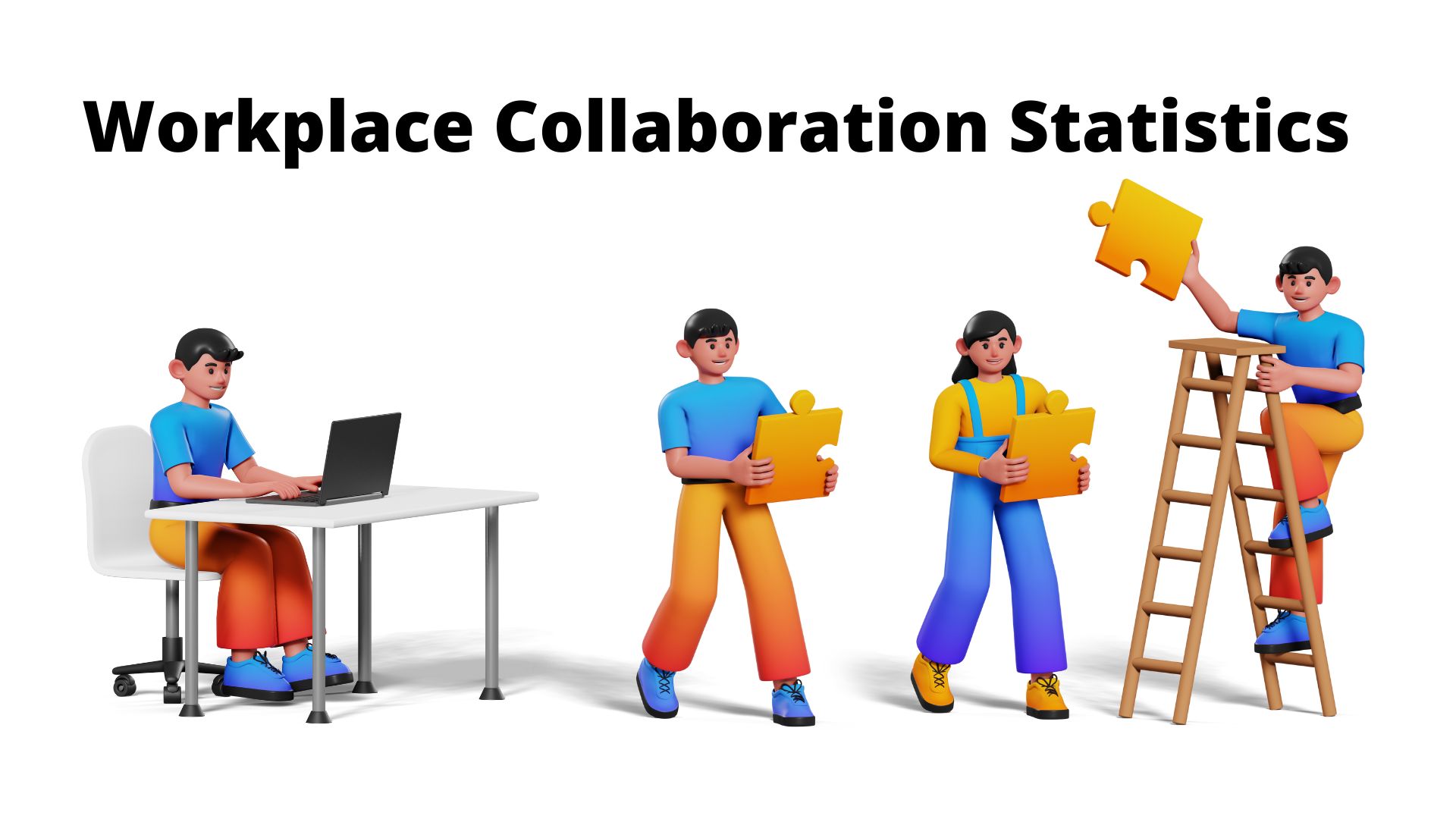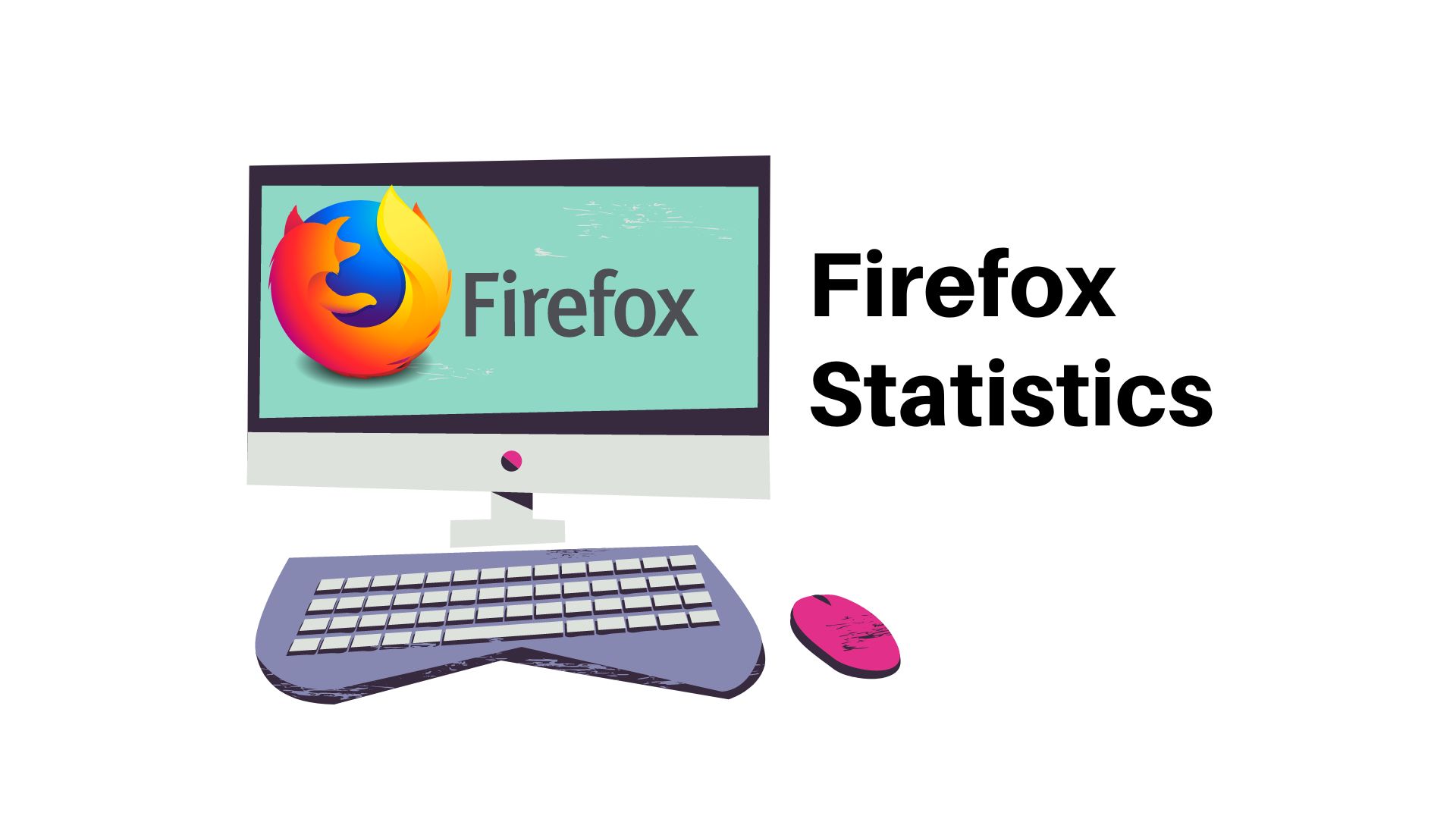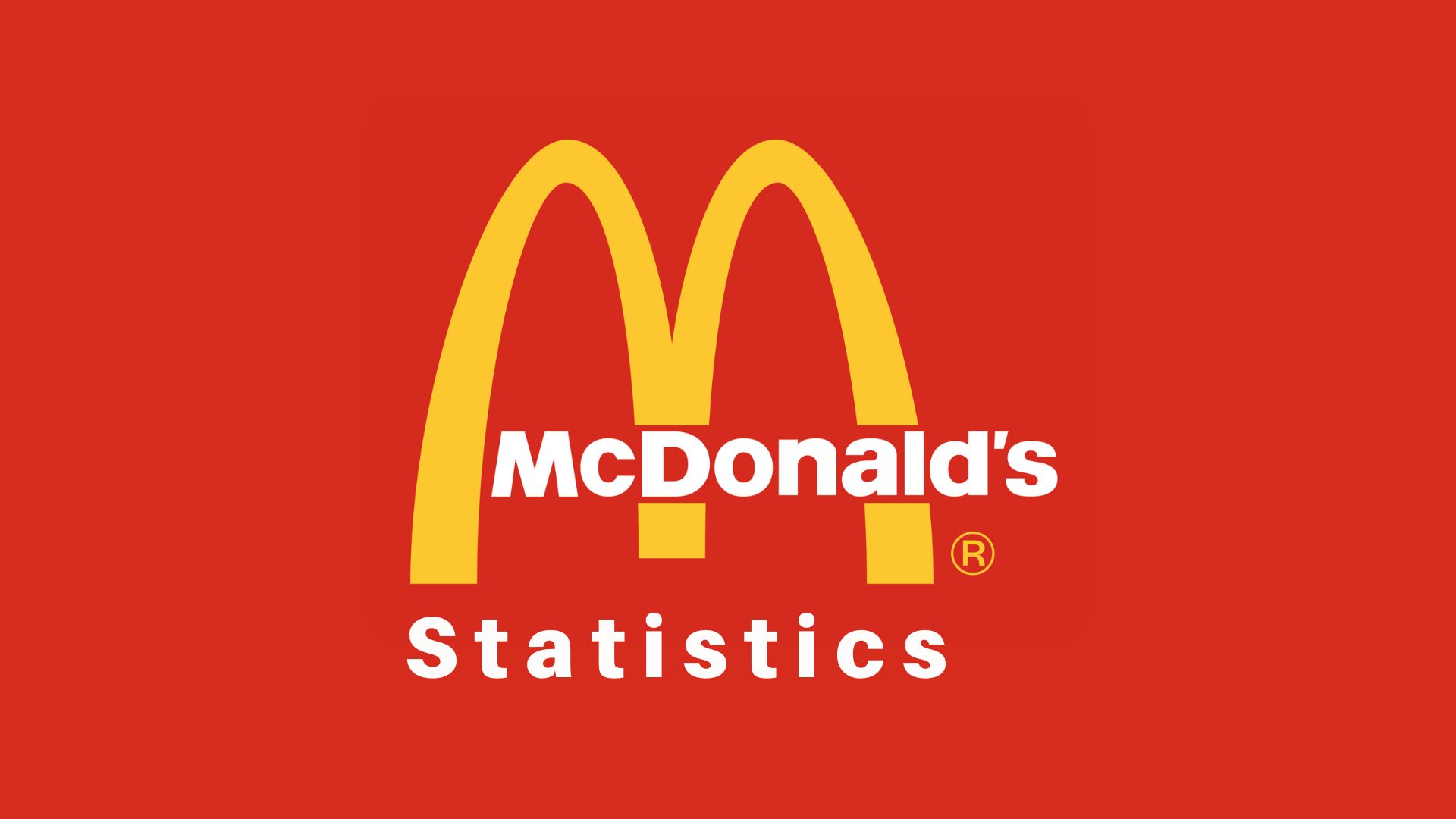25+ Eye-Opening Employee Recognition Statistics For 2023
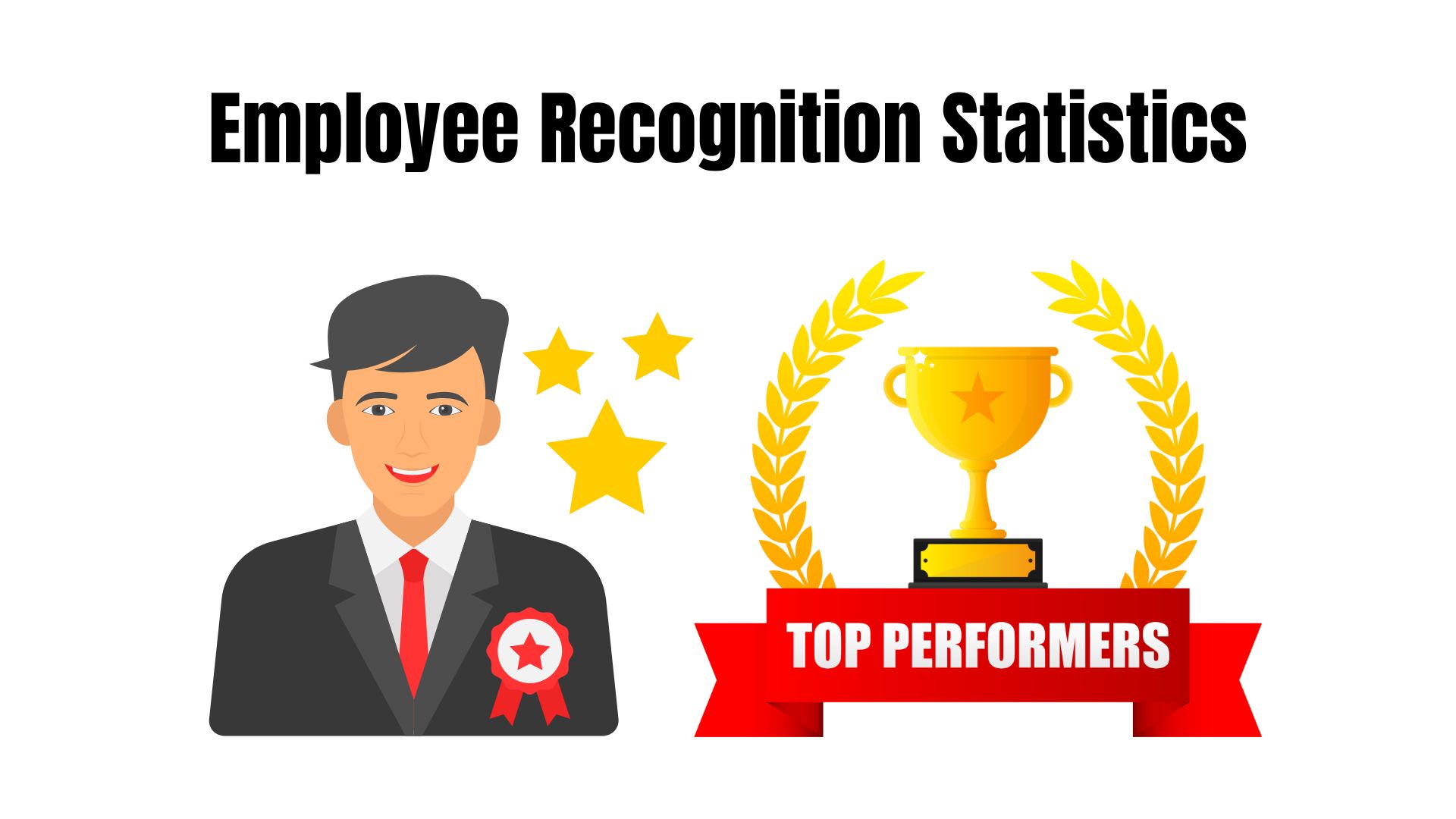
Page Contents
Employee Recognition Statistics: Almost everybody desires to be recognized for their work, whether or not they get paid for their job. Because of this, businesses realize that rewarding employees is essential to keeping their staff members productive, happy, and dedicated to the company.
Employee recognition boosts productivity, helps to build positive relationships, and promotes morale. In addition, employees and the company gain from acknowledging each other's achievements since they enforce high-performance standards.
That is where the recognition value enters the picture to stir things up a little. This article will discuss employee recognition statistics that will also alert you about the risk of working in an environment that discourages the workplace rather than making workers feel valued. To make them simpler for you to understand and organize, we have divided them into various headings.
Most Important Employee Recognition Statistics (Editor's Choice)
- As of 2023, employee recognition enhanced the motivation level by 83.6% of employees making them succeed at their work.
- Frequent recognition results in more productive results claimed by 77.9% of employees.
- Survey reports have observed that age groups between 18 to 24 years received more employee recognition even resulted in 85% productivity.
- The rate of engagement has also improved agreed by
- As of 2023, employee recognition enhanced the motivation level by 83.6% of employees making them succeed at their work.
- Frequent recognition results in more productive results claimed by 77.9% of employees.
- Survey reports have observed that age groups between 18 to 24 years received more employee recognition even resulted in 85% productivity.
- The rate of engagement has also improved agreed by 81.9% of employees.
- Companies these days spend lots of time on employee recognition programs. Around 52.6% of employees remained satisfied with such programs at their organizations.
- In 2023, around 91.7% of companies include a recognition program in 32% are more likely to feel valued by their employers.
- Whereas, 69.7% of companies are without an employee recognition program.
- The highest recognition received at work is on a weekly basis with 32%, others are followed by monthly (23%), daily (18%), yearly (15%), and Quarterly (13%).
- The most valued employee recognition received is from their managers claimed by 40% of employees. Other recognitions are followed by the executive and CEO (33% employees), and Peers (28% employees).
- It has been observed that companies with great culture, well salary offered and effective employee recognition allow 93.5% of employees to stay in the same company for more than 5 years.
- Companies these days spend lots of time on employee recognition programs. Around 52.6% of employees remained satisfied with such programs at their organizations.
- In 2023, around 91.7% of companies include a recognition program in 32% are more likely to feel valued by their employers.
- Whereas, 69.7% of companies are without an employee recognition program.
- The highest recognition received at work is on a weekly basis with 32%, others are followed by monthly (23%), daily (18%), yearly (15%), and Quarterly (13%).
- The most valued employee recognition received is from their managers claimed by 40% of employees. Other recognitions are followed by the executive and CEO (33% employees), and Peers (28% employees).
- It has been observed that companies with great culture, well salaries offered, and effective employee recognition allow 93.5% of employees to stay in the same company for more than 5 years.
- While 3 out of 4 organizations have employee recognition programs, nearly 58% of workers are aware of the existence of that program.
- Nearly 40% of respondents believe they are not recognized enough during Coronavirus disease.
- Effective recognition programs reduce voluntary turnover in their organizations by 31%.
- Approximately 71% of highly engaged companies reward workers for doing a great job. However, only 41% of less involved companies do the same.
- 40% of workers would be more dedicated to their jobs if their efforts were recognized.
- 60% of top-performing organizations report that their employees perform much higher when a company offers various forms of employee recognition.
- Around 83% of HR leaders state that employee recognition may improve organizational values.
- Approximately 24% of workers say their most memorable recognition came from the Chief Executive Officer.
- According to a survey of millennials, approximately 79% stated receiving more awards would make them more devoted to their employer.
- According to Canadian studies, just 12% of workers switch jobs in search of a higher salary.
- The Australian HR Institute highly recommends customized worker benefits.
General Employee Recognition Statistics
#1. While 3 out of 4 organizations have employee recognition programs, nearly 58% of workers are aware of the existence of that program.
According to Josh Bersin, President and Founder of Bersin & Associates, the current $46 billion industry for recognition mainly focuses on tenure-based programs that are clearly failing.
“Any employee recognition program works better than none” is no longer a general rule. Employee recognition program stats show that employees prefer to feel appreciated at work and the occasional “thank you” from their manager.
#2. At least, a single recognition in a month can make 75% of employees satisfied.
As of 2023, it has been observed that 63% of employees will never quit their jobs if they get
recognized. This employee recognition allows for magnifying happiness and productivity by 13%.
#3. Effective recognition programs allow for appreciating employees' efforts and result in 40% of employees being more committed to their jobs.
Employee retention and appreciation is not just a 10-year pin, ribbon, or golden watch. It is about giving workers a sense of specialness and appreciation evident in their job, even if they are caught in the corporate 9 to 5 grind each day.
#4. According to 37% of workers, employee recognition is the most crucial thing their organization or manager can do to inspire staff members to produce outstanding work.
Employees reported that recognition is by far the most common motivator for doing an outstanding job, followed by 13% of respondents stating that they are self-motivated, 12% of workers said that autonomy is their significant motivator, and 12% of respondents stated that they require inspiration to do a great job.
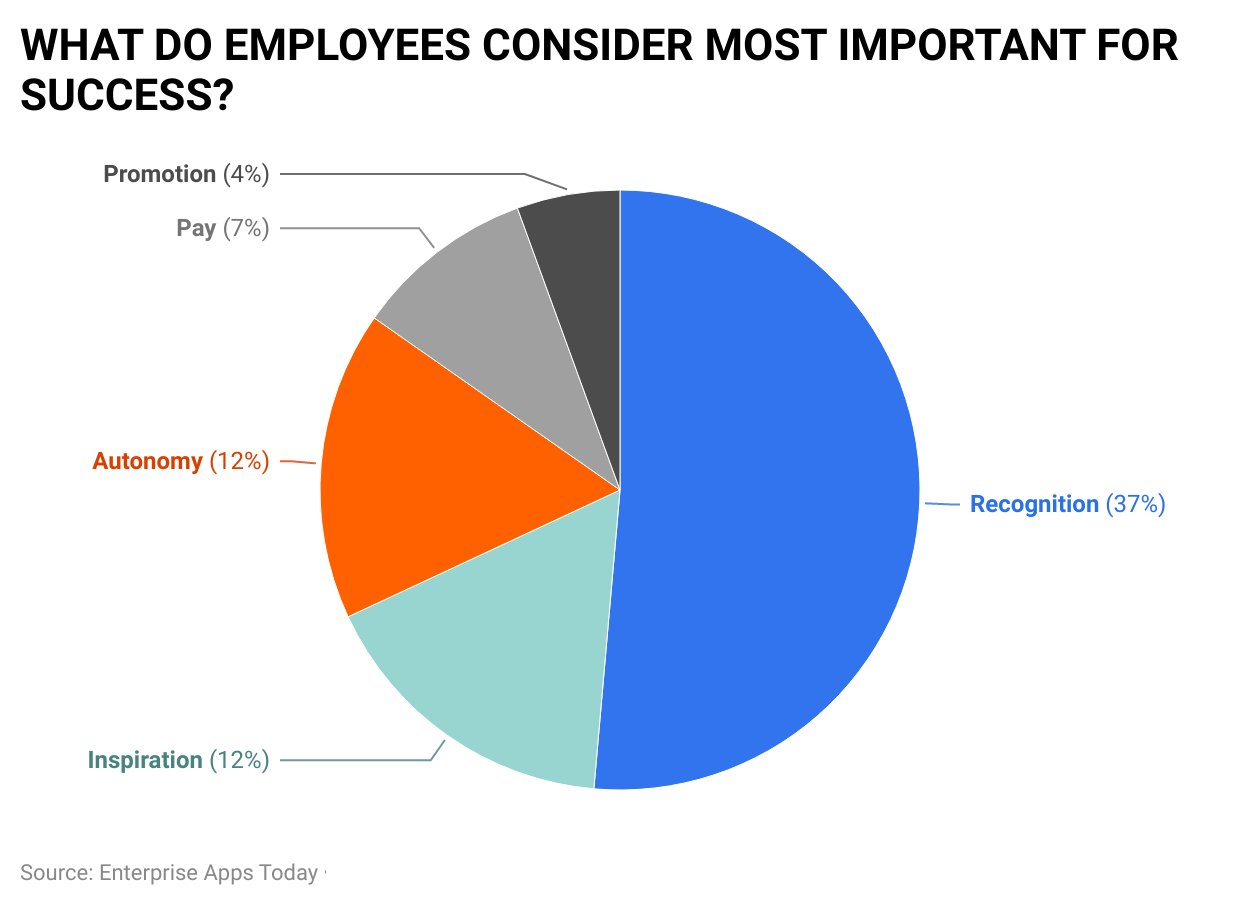
(Source: Zippia)
#5. Weekly motivation and recognition can boost employee performance by 60%.
In the United States, 31.5% of employees remained engaged. On the other hand, the cost of annual incentive programs resulted in $100,000.
#6. Nearly 71% of highly engaged companies reward workers for doing a great job. However, only 41% of less involved companies do the same.
People are wholly devoted to their work in a highly engaged environment. They make discretionary efforts to meet organizational objectives and show appreciation for others who do the same. High participation thereby fosters a culture of gratitude for one another's contributions.
#7. The most valued employee recognition received is from their managers claimed by 40% of employees.
Recognized employees result in productive employees and a company with more than 10,000 employees allows in saving annual cost by $16.1 million.
#8. 60% of top-performing organizations report that their employees perform much higher when a company offers various forms of employee recognition.
Recognizing worker contributions increases productivity, concentration, and job quality while lowering worker increases productivity, engagement, and job quality while reducing the rate. Although a corporation need not implement every possible kind of employee recognition, it should, at the very least, implement some of them. The most common types of employee recognition include:
- The employee of the year month, or week.
- Gamification and incentives.
- Duration of service.
- Peer-to-peer recognition.
- Celebration of significant milestones
- Quarterly or yearly reviews or evaluations.
- Performance-based reward programs.
#9. Organizations with a recognition culture are more likely to retain their staff.
According to the Brandon Hall Group research, worker appreciation and recognition are associated with a 41% higher retention. Moreover, according to stats on employee recognition, engagement rose by 34%.
#10. A well-designed employee recognition program can help improve average worker performance by 11.1%.
One of the best forms of positive feedback workers can get for their great work is recognition. They understand that they are on the correct track and that their actions support the organization's objectives. Because of this, they keep giving their best. Additionally, it encourages other workers to work even harder to meet their objectives.
#11. 29% of workers claim they don't get praise for their work.
Over a quarter of workers report never receiving praise for their efforts, and only 17% of employees say they accept it yearly.
Furthermore, around 20% report receiving recognition every three months, 11% report weekly recognition, and 2% report daily recognition.
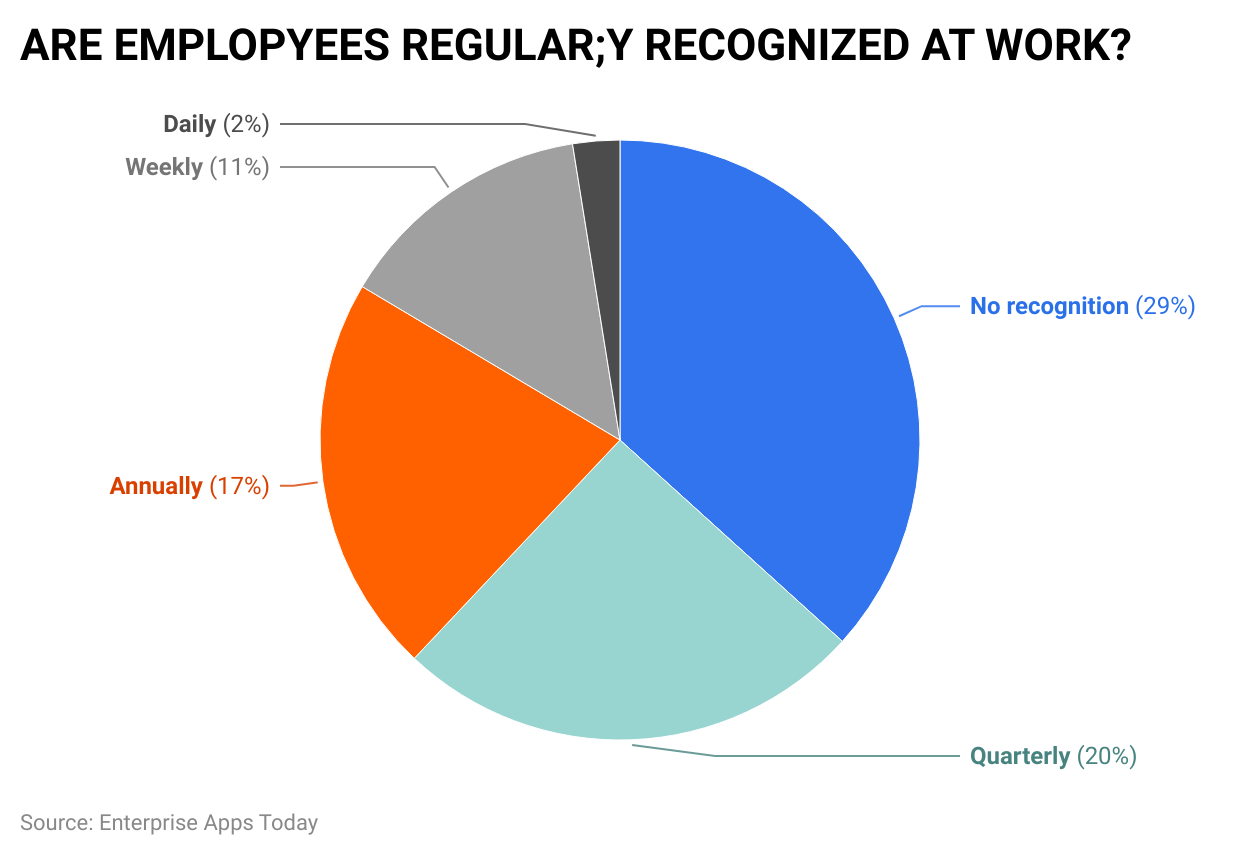
(Source: Zippia)
Employee Recognition Statistics by Methods
#12. As of 2023, businesses spend approximately $3.25 billion.
- To incentivize employees, annually businesses spend around $3.25 billion on merchandise which is a part of recognition programs.
- Almost 87% of companies provide recognition to employees for working effectively at companies depending on tenure.
- Non-cash incentives are preferred by 65% of employees.
#13. The lowest levels of participation are found among those employees working in production and manufacturing industries.
Employee recognition statistics reveal that workers in the manufacturing and production industries have around 23% engagement. Sales employees have a slightly lower engagement rate at 30% than those in the installation and repair industry, which is 31.3%.
Those who work in agriculture, forestry, and fishing showed 33.6% engagement, while managers had a significant level of engagement at 38.4%.
#14. Around 83% of HR leaders state that employee recognition may improve organizational values.
Successful organizations create employee recognition programs that correspond to their core values. Employees can comprehend what the organization expects when they observe a certain behavior regularly. They relate to taking that action to receive rewards. It increases the likelihood that they will do so in the future, enhancing the company's values.
#15. Employees promoted within the company after three years were 70% less likely to quit their jobs.
According to a 32 million-person research conducted by LinkedIn, internally promoted employees have a 70% chance of staying with the organization. If moved laterally, that percentage is 62%; if retained in the same role inside the organization after three years, it is 45%.
#16. In 2023 employees’ affirmation words and recognition gifts are the most common types of recognition.
In a SurveyMonkey study of 1,500 workers on employee recognition, around 36% of employees preferred gifts, while a word of encouragement was preferred by 35% of employees.
#17. Approximately 24% of workers say their most memorable recognition came from the Chief Executive Officer.
A high-ranking supervisor who takes the time to express appreciation might have a favorable impact on a worker. Praise from managers for an employee's dedication, hard work, or achievements can significantly affect engagement and morale.
#18. According to a survey of millennials, approximately 79% stated receiving more awards would make them more devoted to their employer.
The majority of employers tend to view millennials as being unpredictable. However, research indicates that this group can become a company's most valuable asset when valued appropriately.
Furthermore, the millennial generation is a rapidly evolving generation that seeks to be recognized promptly. They are more likely to stay in the organization if they really feel valued.
#19. Nearly 50% of workers think that appreciation from their bosses made them more likable to their superiors.
The relationship between the employer and employee is strengthened when employees are given recognition for their efforts. It might be a compliment, a special letter, a gift, or even the freedom to make decisions about what they do. In addition, recognition is the best way to let workers know that the organization value and trust them.
#20. Employee recognition stats indicate that up to 70% of individuals believe gamification is a poor method of rewarding employees.
Employee competition might be enjoyable, but accumulating points and showing them on a leaderboard will make people feel undervalued at work.
It is essential to encourage and appreciate staff members at every stage of the process rather than pushing them to the bottom of the list, embarrassing them in front of their teammates, or encouraging them to quit.
#21. Men and women receive rewards and appreciation in different ways.
According to research by BambooHR of 1700 individuals, there are gender differences in the frequency and form of recognition received.
For instance:
- Around 50% of the males who responded to the poll stated they get recognition frequently compared to 43% of females. The gap is concerning because the investigation shows no evidence that men perform better than women.
- Gifts given to men seem more expensive than those given to women. Twice as many males receive gifts ranging from $100 to $500 and $500 to $1,000. However, twice as many females receive gifts that are less than $10.
#22. The main drive for coworkers to work harder is their peers, not money.
According to this study, peer recognition is a key element that motivates workers to go the extra mile. Peers' relationships get stronger, and their trust is increased when they acknowledge one another's contributions. Collaboration is more successful because team members feel more connected to the group.
For example, a worker may stay late to assist another employee with their task. Recognizing such sincere effort in front of the team members can increase one's intrinsic motivation to do a great job. In the end, this raises retention and engagement levels.
Employee Recognition Demographics Statistics
#23. Canada's employee recognition stats reveal that the recognition programs in Canada have remained at the same level as in 2013.
Years of Service is the top-level program with 85%, Behavior-Oriented Programs linked with Business Initiatives, with 51%, Above and Beyond Performance, with 77%, Peer to Peer Recognition, with 49%, and Retirement, with 34%, are some of the vital recognition programs in Canada.
#24. According to research by Development Dimensions International Australia, annual reports are a common solution for managers who struggle to communicate with their workforce.
Annual reports are a collection of vague generalizations that do not address individual events – forcing them into the pipeline of obscurity.
Generic in nature and intended to discourage employees from asking for better compensation, the yearly reports are not usual feedback in order to please everyone; ironically enough, they please no one.
#25. According to Canadian studies, just 12% of workers switch jobs in search of a higher salary.
Employers think that people leave their jobs in order to make more money elsewhere, but 88% of Canadians identified 11 additional reasons, including a lack of professional growth, poor cooperation, and communication among team members, poor management, massive workloads, a lack of training, not enough resources & tools, and lack of teamwork. The fifth-ranked category was a lack of recognition at work.
#26. The Australian HR Institute highly recommends customized worker benefits
Ben Thompson, the CEO of the HR portal Employment Hero, asserts that giving younger workers access to a gym membership, fancy gadgets such as a tablet or Bluetooth headphones, and even a cheap mobile phone plan will increase their productivity.
Australia's employee recognition stats reveal that as workers enter their late 20s and early 30s, credit cards, health & life insurance, and restaurant discounts become increasingly significant. In contrast, older workers will be looking toward more leisure time, such as holidays, which is why the company should offer various benefits.
#27. Different generations and demographics need to be managed differently.
According to employee recognition and reward program stats, millennials have the lowest levels of engagement, at just 28.9%. The majority of millennials believe they do not have enough room in their current position for skill development and career growth. On the other hand, baby boomers will do extra if they are given praise and approval from their managers, and they prosper by letting them do what they know best.
Employee recognition statistics also demonstrate that persons with a scholarship degree are less likely to be engaged than those with a high school diploma. This results from the fact that those with diplomas expect to be valued higher due to their higher levels of education.
#28. According to the most recent employee recognition stats for the United Kingdom, engaging workers beyond business can significantly impact performance.
This does not entail involving your staff members in activities outside of work; it means catering and caring for workers beyond the company aspects.
For instance, the British company Specsavers has the aim of delivering optometrical services to its workers, and also it is collaborating with Reward Gateway, a firm that offers its engagement platform through eVouchers. Employees can use the coupons to get the necessary eye care.
Benefits of Employee Recognition
- Improves the rate of employee engagement, and increases productivity believed by 52% of employees in 2023.
- Companies with a rich recognition culture have a 31% lower voluntary turnover rate.
- Employee recognition allows 40% of American employees to do more work.
- In the 2nd quarter of 2023, almost 90% of employees have received recognition by their boss.
- Weekly recognition has also reduced the rate of employee absenteeism by 27%.
Conclusion
The workplace is currently undergoing a number of changes. A growing portion of our staff comprises millennials, who firmly think great work deserves timely recognition. Companies are now engaged in fierce talent competition as the demand for a highly skilled workforce increases. An environment of recognition not only helps to retain workers and attracts top talent.
Furthermore, Global catastrophes like the COVID-19 pandemic also contribute to widespread uncertainty, instability, and stress. Employees who put in a lot of effort deserve to be appreciated more than ever.
Recognition is becoming more important than merely being pleasant in a workplace. Companies like Apple and Zappos use it as a potent business tactic to reduce attrition and boost retention.
The above Employee recognition statistics prove that recognition programs are a must-have for companies worldwide. It's time for you to step up your recognition initiatives as well. Develop a thriving culture of recognition by investing in the appropriate resources and talent.
Sources
FAQ.
Employee recognition awards, gifts with the organization branding or gadgets, compliments, unrecorded time off, nominations, approvals, team dinners, bonuses, entertainment discounts, etc., are a few excellent options for employee recognition.
The term "recognition" refers to unofficial praises and appreciation for excellent work that can be delivered at any time by coworkers or management at the firm. On the opposite end of the scale, rewards and incentives are more closely related to objectives and accomplishments.
You can literally make them happy. The good thing about happy workers is that they are devoted to the firm they work for, go above and beyond for their customers or clients, are more communicative and positive, and will likely stay with the company.
Staff member recognition means appreciating, supporting, and valuing certain behaviors, activities, and practices, i.e., excellent performance at work that increases a company's productivity and helps it meet its financial objectives. Recognition might be official or casual, but it must always be given in a timely manner.
It is very significant! It is the driving force behind a productive workplace. Appreciation and a sense of belonging among a group of individuals and in a company, as well as the commitment to the exact broader cause, is the social proof that our work really does make a difference.
According to employee recognition stats, regular feedback, nominations, or interactions and rewards make workers feel appreciated and valued, which in turn promotes the growth and success of the business.
According to employee recognition stats, when employees feel proud to work for a certain organization, they are more likely to handle their responsibilities well and complete their tasks on time.
There is recognition by supervisors as well as Peer-to-peer recognition. Recognition can also be informal or formal. A simple thank-you note on the worker's desk or praise would be examples of informal recognition, whereas an employee appreciation letter would be a suitable example of official recognition.
An excellent worker recognition program will increase engagement by selecting an employee of the year, Retirement and years of service gifts, giving out customer service and sales awards, and tenure recognition.
According to employee recognition stats, regular recognition is significantly better than an annual review. It's a win-win situation for your brand and staff members if you acknowledge their hard work and efforts once every seven days.

Michael Singer is a career coach, podcast host, and author to help you step into a career you're excited about. Currently, He is a coach and trainer helping entrepreneurs and executives achieve business and leadership success. He is also an award-winning business journalist focused on the intersection of technology, Big Data, Cloud, SaaS, SAP, and other trending technology.
